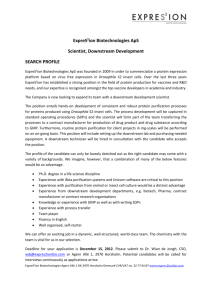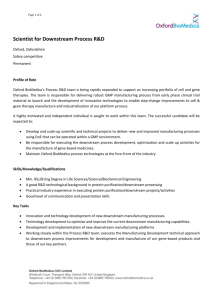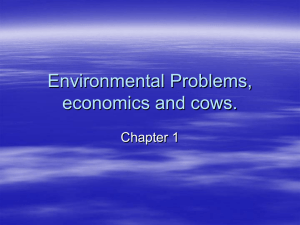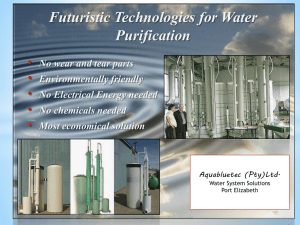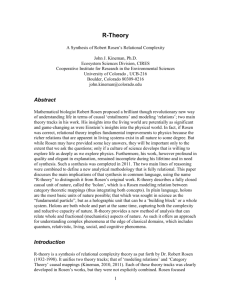Downstream Processes - Biological Engineering
advertisement
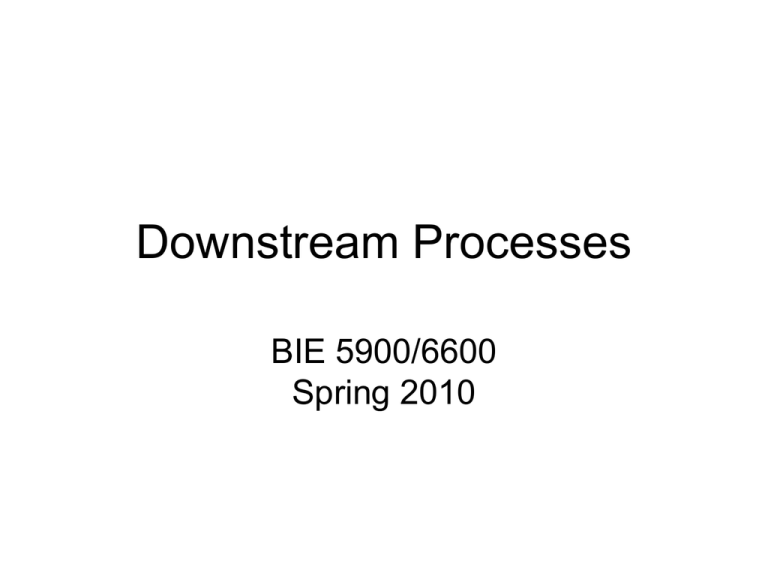
Downstream Processes BIE 5900/6600 Spring 2010 Products • From plant, animal or microbial cells • Biomass – Algae for anaerobic digestion and for biodiesel – Anaerobic digester sludge for land application as fertilizer • Extracellular component – Excreted proteins – Metabolic products – organic acids, alcohols • Intracellular component – Cytoplasmic or membrane proteins – Lipids - biodiesel Partly Science and Partly Art! (Reference: Dr. Sridhar Viamajala for slides, with some modifications by Dr. Ron Sims) Cost determinants • # of unit operations – ↑ equipment and ↑ processing ↑ cost • Concentration of product at start of downstream process – Concentrating dilute products requires higher throughput • Purity and activity required – Polishing steps are often more expensive – Pharmaceutical products – Analytical grade chemicals/enzymes • Yield Cost determinants (cont.) Source: Doran PM, Bioprocess Engineering Principles. 7th ed, 2002. Dwyer Plot: Relationship between selling price and concentration before downstream processing Biotech products market Reference: Textbook (Harrington, et al., Bioseparations Science and Engineering Bioproduct categories Bioproducts cont. • Small biomolecules – Primary metabolites: produced during growth • Sugars – Sucrose: sugarcane, sugar beets – Fructose: by glucose isomerase – Glucose: amylase treatment of starch • Organic acids, alcohols, ketones – Anaerobic fermentation • Vitamins – Organic synthesis – Plant sources and microbial fermentation • Proteins – Highest commercial value - Pharmaceutical industry – Produced from microbial, plant and animal cells • Lipids – Plants and microorganisms (algae) – Products include steroids and biodiesel Bioproducts cont. – Secondary metabolites – produced during stationary phase • E.g. antibiotics such as penicillin • Sources include fungi, bacteria, plant and animal tissues Protein classification Factors affecting protein activity/stability • Physical stability – Temperature • Mechanical stability – Shear stress – Pressure – Surface tension • Chemical stability – – – – pH Solvents Chaotropic agents – break hydrophobic interactions Detergents – for solubilizing cell membranes to purify membrane bound protein • Biological Attack – Proteolysis Source: Burgess R, Protein Purification in Protein Engineering, DL Oxender and CF Fox, eds., Alan R. Liss, Inc., 1987. Protein properties determine purification strategy • Size and shape – 3D structure, prosthetic groups – Protein/enzyme activities must be preserved!! • Charge and pI – Net charge depends on pH • Charge distribution – Depends on protein folding and 3D structure – Surface charge maybe different from overall charge • Hydrophobicity • Aggregation – Reversible or irreversible • Solubility – Depends on all the above • Density • Ligand/metal binding – Affinity properties Source: Burgess R, Protein Purification in Protein Engineering, DL Oxender and CF Fox, eds., Alan R. Liss, Inc., 1987. Pre-Purification Steps You know what protein to purify and you know all its properties – what do you do next? Step 1: Choose or Make a RICH source • Host selection – Procaryote • Gram –ve (E. coli) • Gram +ve (B. subtilis) – Eucaryote • Yeast • Mammalian • Plant • Target location – – – – – – Extracellular Cytoplasmic Periplasmic Membrane bound Organelle Inclusion bodies Pre-Purification Steps (cont.) Host Selection Source: Blanch HW and Clark DS. Biochemical Engineering. Marcel Decker, Inc., 1996 Pre-Purification Steps (cont.) You know what protein to purify, you know all its properties and you have a source – what next? Step 2: Develop an assay • Purity – Electrophoresis • PolyAcrylamide Gel Electrophoresis (PAGE) – – • Isoelectric focusing (IEF) – – • Separates based on isoelectric point Varying pH, constant pore size Concentration – UV absorption – Protein assay • • 280 or 254 nm Bradford Method – – – • • Coomassie dye binds to Arginine and hydrophobic amino acids Unbound dye is green and bound dye is blue (595 nm) High Sensitivity Lowry Method – – – – Cu(II) in alkaline solution reacts complexes with protein Protein-Cu(II) complexes react with Folin-Phenol reagent (phosphotungstic acid + phospomolybdic acid + phenol) Product is blue and can be detected at 630 nm Less sensitive than the Bradford method Antibody-based Assays – – – – – • Separates based on size/charge ratio Constant pH, varying pore size Protein-specific antibody binds to protein, (1º antibody) (Protein+ 1º antibody) complex is reacted with a 2º antibody that carries a fluorescent molecule Fluorescence can be visualized and/or quantified Extremely sensitive method If 2º antibody is an enzyme the method is called Enzyme-Linked ImmunoSorbent Assay (ELISA) Activity – – Activity assays with protein/enzyme-specific substrates Can be done in-situ on proteins separated on a non-denaturing gel Source: Garcia AA, Bonen MR, Ramirez-Vick J, Sadaka M, Vuppu A. Bioseparation Process Science. 1st ed., Blackwell Science, 1999 Stages of Downstream Processing (Table 1.9) Stage Unit Operations 1. Separation of insolubles filtration, sedimentation, extraction, adsorption 2. Isolation of Product extraction, adsorption, ultrafiltration, precipitation 3. Purification chromatography, crystallization, fractional precipitation 4. Polishing drying, crystallization Typical flow diagram of a protein production facility Source: Datar R and Rosen CG. Downstream Process Economics in Separation Processes in Biotechnology, Asenjo J ed., MarcelDekker, Inc., 1990 Typical flow diagram of a protein production facility Fermentation – upstream processing Source: Datar R and Rosen CG. Downstream Process Economics in Separation Processes in Biotechnology, Asenjo J ed., MarcelDekker, Inc., 1990 Typical flow diagram of a protein production facility Harvest and removal of solids Source: Datar R and Rosen CG. Downstream Process Economics in Separation Processes in Biotechnology, Asenjo J ed., MarcelDekker, Inc., 1990 Typical flow diagram of a protein production facility Primary recovery Source: Datar R and Rosen CG. Downstream Process Economics in Separation Processes in Biotechnology, Asenjo J ed., MarcelDekker, Inc., 1990 Typical flow diagram of a protein production facility Secondary recovery and polishing Source: Datar R and Rosen CG. Downstream Process Economics in Separation Processes in Biotechnology, Asenjo J ed., MarcelDekker, Inc., 1990 Basic Principles of Engineering Analysis Three principal ingredients of engineering analysis 1. Material Balance Accumulation = inflow - outflow + amount produced - amount consumed 2. Equilibria A+B=C Keq = _[C]_ [A][B] Keq = [CS] Partition coefficient when two phases are involved [C] 3. Transport Phenomena (flux) flux = coefficient x driving force Example: Ohm’s law Je = CE Example: Diffusive flux (Fick’s first law) JD = -D dc/dx Example: Flow through porous medium (Darcy’s Law) Jw=Lpdp Process and Product Quality Purity = _____amount of product__________________ (1.8.11) amount of product + amount to total impurities Specific activity = __units of biological activity__ mass (1.8.12) Yield = amount of product produced amount of product in feed (1.8.13) Fold Purification = __purity at any stage in the process________ purity at the state of the purification process Criteria for Process Development Use of developing and evaluating a bioseparation process Product purity Cost of production as related to yield Scalability Reproducibility and ease of implementation Robustness with respect to process stream variables Route to Market Section 1.9.3 GLP and cGMP GLP = good laboratory practice cGMP = current good manufacturing practice IND = investigative new drug “the process defines the product”
